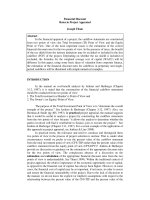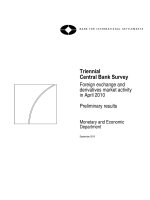Essential Formulae in Project Appraisal ppt
Bạn đang xem bản rút gọn của tài liệu. Xem và tải ngay bản đầy đủ của tài liệu tại đây (193.81 KB, 18 trang )
1
Chapter 5: Essential Formulae
in Project Appraisal
A Coverage of the Formulae and
Symbols Used to Evaluate
Investment Projects
2
Fundamentals in Financial
Evaluation
Money has a time value: a $ or £ or €
today, is worth more than a $ or £ or € next
year.
A risk free interest rate may represent
the time value of money.
Inflation too can create a difference in
money value over time. It is NOT the
time value of money. It is a decline in
monetary purchasing power.
3
Moving Money Through Time
Investment projects are long lived, so
we usually use annual interest rates.
With compound interest rates, money
moved forward in time is
‘compounded’, whilst money moved
backward in time is ‘discounted’.
4
Financial Calculations
Time value calculations in capital
budgeting usually assume that
interest is annually compounded.
‘Money’ in investment projects is
known as ‘cash flows’: the symbol is:
C
t
Cash flow at end of period t.
×
5
Financial Calculations
The present value of a single sum is:
PV = FV (1 + r)
-t
-
the present value of a dollar to be received at
the end of period t, using a discount rate of r.
∑
+
=
t
t
t
r
CF
PV
1
)1(
The present value of series of cash
flows is:
6
Financial Calculations:
Cash Flow Series
A payment series in which cash flows
are Equally sized And Equally timed
is known as an annuity.
There are four types:
1. Ordinary annuities; the cash flows
occur at the end of each time period.
2. Annuities due; the cash flows occur at
the start of each time period.
7
Financial Calculations:
Cash Flow Series
3. Deferred annuities; the first cash
flow occurs later than one time
period into the future
4. Perpetuities; the cash flows begin at
the end of the first period, and go on
forever.
Annuities: types 3 and 4.
α
8
Evaluation of Project Cash Flows.
Cash flows occurring within investment
projects are assumed to occur regularly, at
the end of each year.
Since they are unlikely to be equal, they will
not be annuities.
Annuity calculations apply more to loans and
other types of financing.
All future flows are discounted to calculate a
Net Present Value, NPV; or an Internal Rate
of Return, IRR.
9
Decision Making With Cash
Flow Evaluations
If the Net Present Value is positive,
then the project should be accepted.
The project will increase the present
wealth of the firm by the NPV amount.
If the IRR is greater than the required rate of
return, then the project should be accepted.
The IRR is a relative measure, and does not
measure an increase in the firm’s wealth.
10
Calculating NPV and IRR With
Excel Basics.
1. Ensure that the cash flows are recorded
with the correct signs: -$, +$, -$, +$ etc.
2. Make sure that the cash flows are evenly
timed: usually at the end of each year.
3. Enter the discount rate as a percentage,
not as a decimal: e.g. 15.6%, not 0.156.
4. Check your calculations with a hand held
calculator to ensure that the formulae
have been correctly set up.
11
Calculating NPV and IRR With
Excel The Excel Worksheet.
12
Calculating MIRR and PB With
Excel.
Modified Internal Rate of Return – the
cash flow cell range is the same as in the
IRR, but both the required rate of return,
and the re-investment rate, are entered into
the formula: MIRR( B6:E6, B13, B14)
Payback – there is no Excel formula . The
payback year can be found by inspection
of accumulated annual cash flows.
13
ARR and Other Evaluations
With Excel.
Accounting Rate of Return – there is no
Excel formula. Average the annual
accounting income by using the ‘AVERAGE’
function, and divide by the chosen asset
base.
Other financial calculations – use Excel ‘Help’ to find
the appropriate function. Read the help information
carefully, and apply the function to a known problem
before relying on it in a live worksheet.
14
Calculating Financial Functions
With Excel Worksheet Errors.
Common worksheet errors are:
Cash flow cell range wrongly specified.
Incorrect entry of interest rates.
Wrong NPV, IRR and MIRR formulae.
Incorrect cell referencing.
Mistyped data values.
No worksheet protection.
15
Calculating Financial Functions
With Excel Error Control.
Methods to reduce errors:
Use Excel audit and tracking tools.
Test the worksheet with known data.
Confirm computations by calculator.
Visually inspect the coding.
Use a team to audit the spreadsheet.
16
Essential Formulae Summary
1.The Time Value of Money is a cornerstone
of finance.
2. The amount, direction and timing of cash
flows, and relevant interest rates, must
be carefully specified.
3. Knowledge of financial formulae is
essential for
project evaluation.
17
Essential Formulae Summary
4. NPV and IRR are the primary
investment evaluation critertia.
5. Most financial functions can be
automated within Excel.
6. Spreadsheet errors are common. Error
controls should be employed.
18
Essential Formulae Summary
7. To reduce spreadsheet errors:
-document all spreadsheets, keep a list of
authors and a history of changes, use
comments to guide later users and
operators.
8. Financial formulae and spreadsheet
operation can be demanding. Seek help
when in doubt.
$ % $ % $ % $ % $ % $ % $ % $ % $ %$ %









